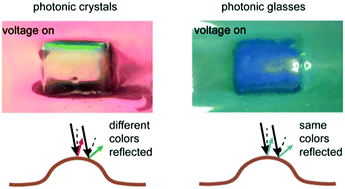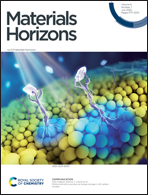Voltage-tunable elastomer composites that use shape instabilities for rapid structural color changes†
Abstract
Structurally colored materials can switch colors in response to external stimuli, which makes them potentially useful as colorimetric sensors, dynamic displays, and camouflage. However, their applications are limited by the angular dependence, slow response, and absence of synchronous control in time and space. In addition, out-of-plane deformation from shape instability easily occurs in photonic films, leading to inhomogeneous colors in photonic-crystal materials. To address these challenges, we combine structurally colored photonic glasses and dielectric elastomer actuators. We use an external voltage signal to tune color changes quickly (much less than 0.1 s). The photonic glassses produce colors with low angular dependence, so that their colors are homogeneous even when they become curved due to voltage-triggered instabilities (buckling or wrinkling). As proof of concept, we present a pixelated display in which segments can be independently and rapidly turned on and off. This wide-angle, instability-tolerant, color-changing platform could be used in next-generation soft and curved color displays, camouflage with both shape and color changes, and multifunctional sensors.



 Please wait while we load your content...
Please wait while we load your content...
